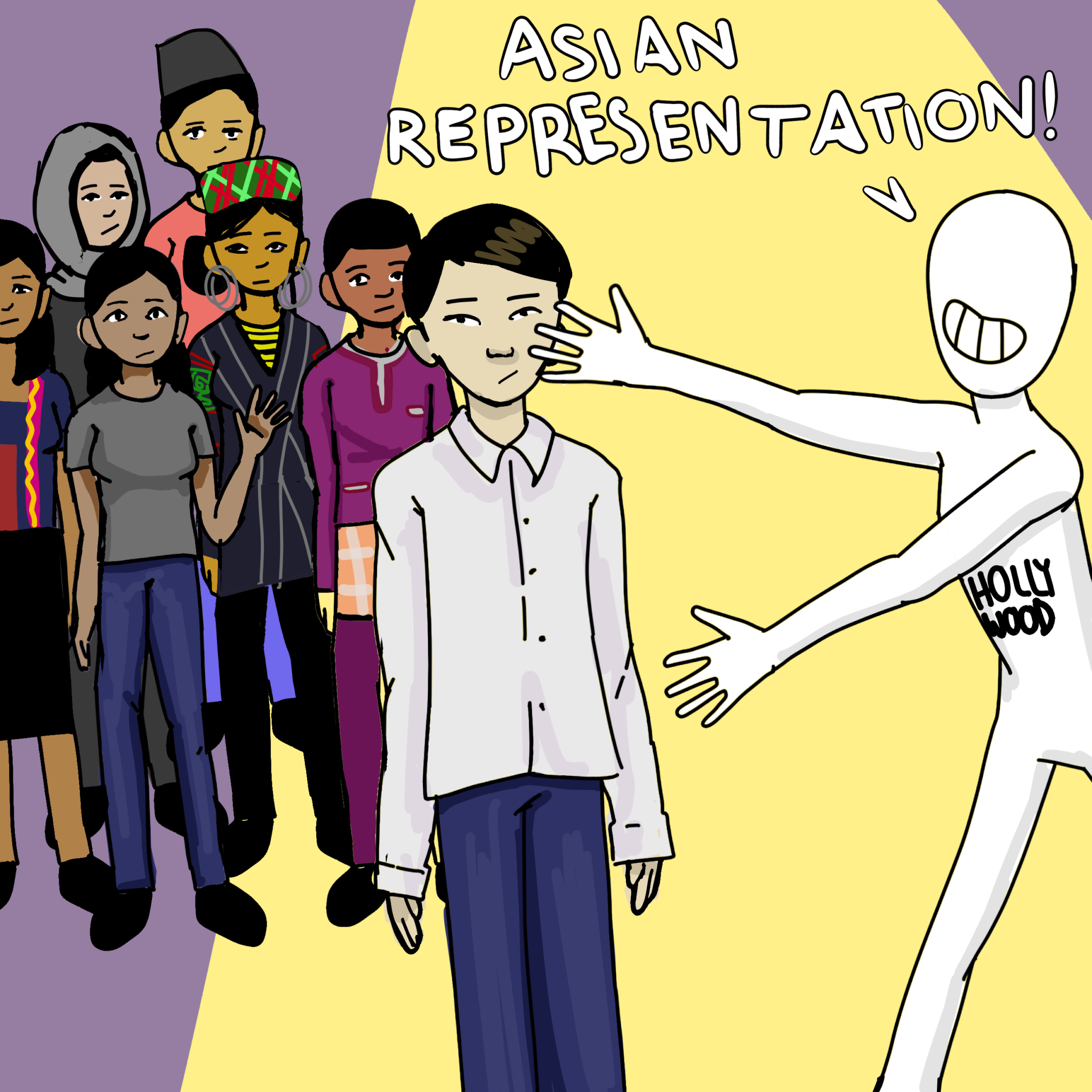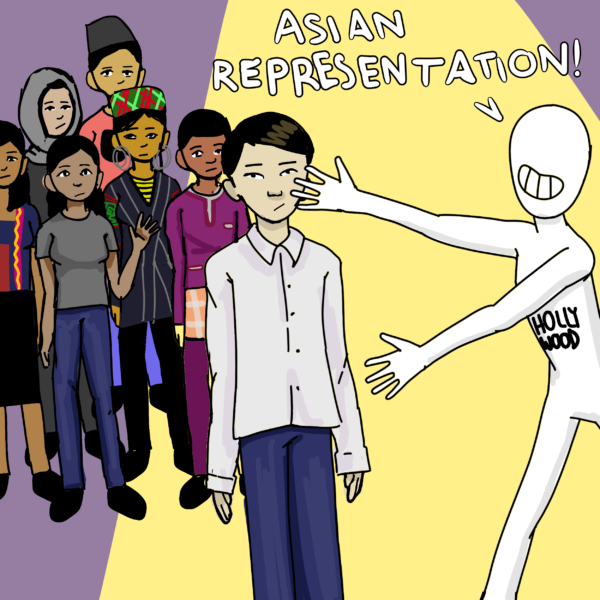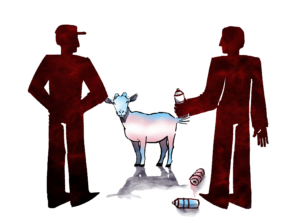

Before I watched the movie “Crazy Rich Asians,” I remember assuming “Asians” would yet again equate to East Asians, and the movie would take place in China, Japan or another East Asian country popularized in Western media. I was pleasantly surprised to find out the movie took place in Singapore, where my aunt used to live. Still, the movie brought to my attention the media’s lack of Asian diversity that I had accepted as normal.
The official definition of Asian, as quoted from the U.S. Census Bureau, is “[a] person having origins in any of the original peoples of the Far East, Southeast Asia, or the Indian subcontinent.” Yet many people struggle to identify some groups as Asian. In a 2016 survey conducted by the National Science Foundation, 15% to 17% of white, Black, Latino and Pacific Islander interviewees said Filipinos were not likely to be Asian Americans. Numbers like these are not necessarily due to a racist mindset but rather an uninformed one.
In the media, being Asian means two things: South Asians watch Bollywood movie musicals, eat spicy food and smell like curry, and East Asians are good at math, have small eyes and an affinity for rice. From Baljeet’s meltdowns over poor grades in the cartoon “Phineas and Ferb” to Long Duk Dong’s thick accent and foreign-sounding name in the popular movie “Sixteen Candles,” the widespread stereotyping of Asians in the media is not something that can be ignored.
Between these overly clear-cut definitions of South and East Asians lies a marginalized group: Southeast Asians, who are forced to identify with the media’s warped definition of Asian rather than with their own unique identity. Southeast Asia is a region south of China and east of the Indian subcontinent. It consists of 11 countries, including Indonesia and Thailand, spread between mainland Asia and a group of island chains commonly known as insular Southeast Asia.
[R]ather than a show of support and diversity, this “progress” is mere tokenism, included for the sake of seeming progressive
Often, this group is left out in the media. By consequence, Southeast Asians are marginalized, and their identity is questioned by the general public. They are marginalized even by other Asians and Asian Americans, who consider Southeast Asians too dark to be true Asians. This view is then internalized by the people of this forgotten region, where whitening creams and pale makeup are applied to fit Asian beauty standards, and a fair complexion is portrayed to guarantee success, an idea stemming from field workers being tanner than elite people due to extensive sun exposure.
Some progress seems to have been made to include Southeast Asians in the media, most notably in gaming. Famous video games such as “Hyperscape” and “Overwatch” have included characters from Southeast Asia.
However, rather than a show of support and diversity, this “progress” is mere tokenism, included for the sake of seeming progressive. A white character can be anywhere on a range of intelligence, religion and rebelliousness. On the other hand, characters of different races often become a sum of stereotypes — wearing traditional clothing, speaking broken English with occasional phrases in their native tongue. The popular video game “Hyperscape” is just one example: the character Noor Casulink hails from Pekan, Pahang, Malaysia and speaks a mixture of Malay and English. Donning a headscarf, she seems to represent the 61.3% of Malaysians who practice Islam (as found by the 2010 census) perfectly.
Rather than accepting a stereotypical side character as an indication of diversity, seeing a strong minority protagonist should be normalized
While on the surface this token may seem like a solution, it is impossible to include one Southeast Asian character and claim to support diversity when this disingenuous action does nothing more than group together a diverse population of individuals, select a few defining qualities — Muslim, Malay-speaking, olive-skinned — and assume that is enough representation to satisfy the Southeast Asian market. Rather, it creates a harmful and one-dimensional view of Southeast Asians, separate from their true identities.
A similar issue occurs when Southeast Asia is blatantly misrepresented, because reality doesn’t fit into existing stereotypes. The British television show “Cold Feet” altered scenes of Singapore, because despite being shot in the country, it didn’t look “authentic” to the production team. At first, they assumed the camera crew had rushed and shot the scene locally. When they realized the shots were taken in Singapore, they guessed they were from an “Englishtown” in Asia similar to a “Chinatown” in the U.S., refusing to believe Singapore is a well-developed country with English as its national language.
Instead, the visual effects team of the show edited the Singaporean shots, changed the street signs to Chinese, removed British tourists and added foreign buildings. The producers’ perception that Singapore was a third-world, underdeveloped country led them to create a show that only perpetuated stereotypes of Southeast Asian countries rather than exposing falsehoods and changing viewer’s mindsets.
Southeast Asian representation is just one of many examples where the media leaves out or stereotypes a group of people under the false pretense of diversity. East Asians make up less than half of the population of Asians in America yet almost all of the Asian representation in the media. It is a poor reflection on us that we can claim our country to be a land of freedom where all are welcome but have such difficulty reflecting that diversity on the big screen. Rather than accepting a stereotypical side character as an indication of diversity, seeing a strong minority protagonist should be normalized.






I wish I could sing this article from the top of my lungs. Thank you for this. Sincerely, an underrepresented South East Asian- American woman
thank you for writing this article, i teared up a bit while reading this because of how much i can relate. As a Cambodian person who was born in Cambodia but moved abroad at a young age, i see that there are not a lot of South East Asian representation. People would always guess or asked me if I’m from South Asia or more specifically Indian because of my brown skin. At a young age i would often tell myself that my skin is the reason why l don’t have a lot of friends in primary school or not having a boyfriend cause I’m a brown skin Asian and not a pale Asian like my East Asian friend, even my own Asian friend don’t really consider me as a true Asian. I would use my mum bleaching soap to bleach my skin so i can look like my pale skin Chinese friend and wishing i was born white so i can wear any colour i want. When my school talk about racism it would always be about East Asian and the Black community or talking about colourism, it would always about the black community. But there was nothing about South East Asia.
If it was about South East Asia it would always about poverty and struggle the people are facing but never our culture, our music our dance our food our people our tradition.